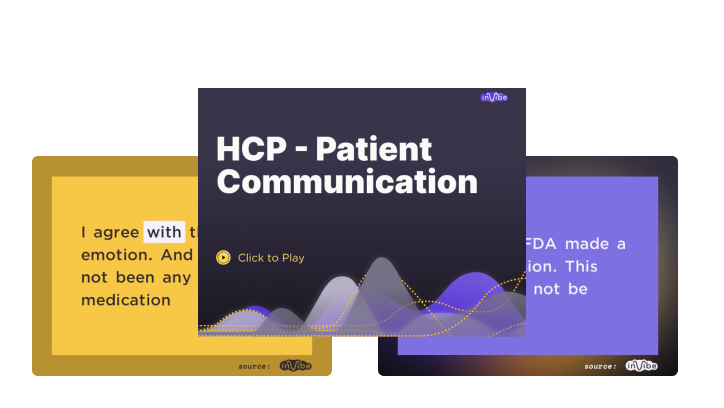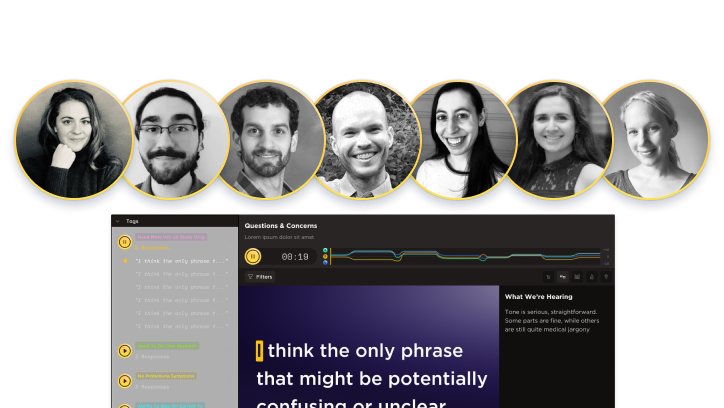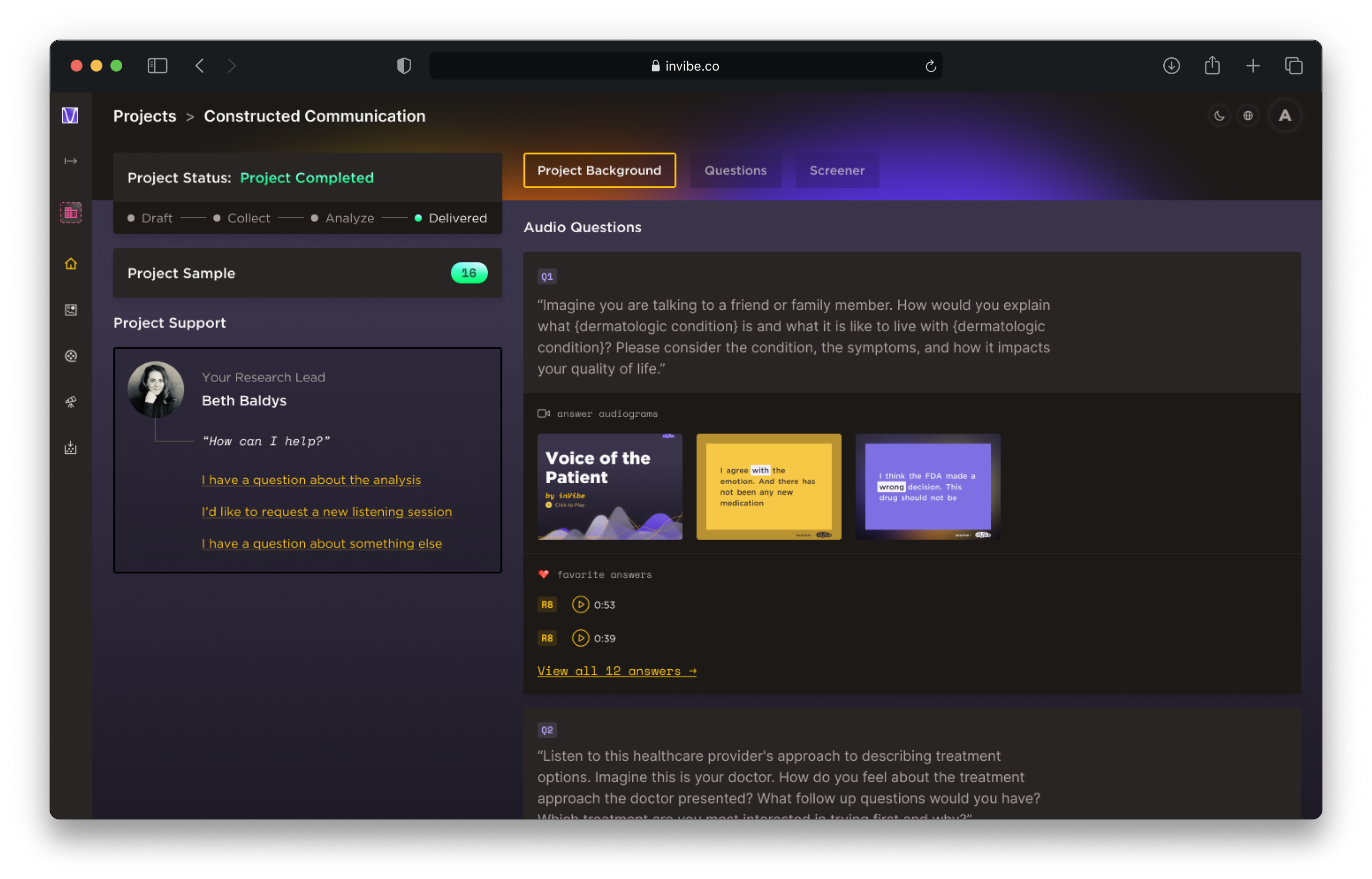Use Case
HCP – Patient Communication
Case Study
Using Voice Stimuli to Reveal Gaps in HCP - Patient Communication
Client Goal
Prior to the upcoming launch of their new product, our clients aimed to understand how patients and HCPs communicated and felt about a dermatologic condition. Our client needed to: a) uncover natural language both parties used to talk about symptoms & treatments, and; b) identify effective communication strategies as well as current misunderstandings between patients and HCPs.
Objective 1
Uncover the lexicon HCPs and patients use to discuss symptoms, unmet needs, disease experiences, and treatments.
Objective 2
Explore communicative roles and dynamics to identify what is working well in the current conversation between HCPs and patients, as well as where these conversations could be optimized.
The inVibe Solution
inVibe’s Constructed Communication solution allowed our pharmaceutical client to quickly and efficiently deploy a multi-phased voice-powered research study to better understand communication trends for this dermatologic condition.
1. Collect
In Phase 1, inVibe screened and recruited 10 patients and 10 HCPs with the relevant dermatological experience to participate in an automated phone interview, responding to questions simply by speaking.
The voices captured in the Phase 1 of research were then used in Phase 2, wherein inVibe screened and recuited 20 patients and 35 HCPs for an automated phone interview. In Phase 2, patients reacted to voices of real HCPs and vice versa to create an interactive communicative environment.
Key Questions
/
Patient
Phase 1
Imagine you are talking to a friend or family member. How would you explain what {dermatologic condition} is and what it is like to live with {dermatologic condition}? Please consider the condition, the symptoms, and how it impacts your quality of life.
Phase 2
Listen to this healthcare provider’s approach to describing treatment options. Imagine this is your doctor. How do you feel about the treatment approach the doctor presented? What follow up questions would you have? Which treatment are you most interested in trying first and why?
Key Questions
/
HCP
Phase 1
Imagine you’re reviewing different treatment options with a newly diagnosed {dermatologic condition} patient. How would you present the available treatment options, as well as the benefits and drawbacks of each? Please respond as if you were explaining these options to a patient.
Phase 2
Please take a moment to listen to this patient describe how her {dermatologic condition} symptoms affect her daily life. Imagine this patient came to you for treatment. How would you respond to her after she shared this information? What follow up questions would you ask?
2. Analyze
inVibe’s analysts leveraged their language expertise and advanced NLP tools to process, evaluate and analyze multiple aspects of each response, including content, language, and emotion derived from speech-emotion recognition, allowing for deeper insights, faster.
What is Said
Summarize and categorize the content and themes.
How it’s Said
Identify the language patterns and construction.
How it Sounds
Utilize machine learning and acoustic technology to assess the emotionality.
3. Deliver
The client was provided with an interactive report via an online dashboard, along with the voice data, transcripts, and a detailed analytical report at each phase. In-house analysts walked the client through the most meaningful data, supporting each insight with specific voice data.
Audiogram
Videos
Clients have access to drag & drop tools to instantaneously create kinetic text animations from transcripts for internal sharing.

Expert
Perspective
inVibe’s team of in-house analysts and language experts walk clients through the insights and recommendations derived from the research.


Key Insights & Recommendations
Based on the insights, inVibe recommended that the team take strategic actions:
#1
Support patients and encourage better discussions during diagnosis by reassuring patients that they are not to blame for their symptoms, and by acknowleding both the physical pain and psychological impact symptoms have on their lives.
#2
Work to break the mold of the ‘step-wise’ treatment approach that is currently standard among physicians, and often leaves patients frustrated. Activating patients to vocalize their first-choice therapy and symptom experience may enable them to get to later line therapy sooner.
#3
Simply and transparently establish [client's new treatment] safety profile to mitigate patient concerns about later line therapies being “aggressive,” while ensuring it is framed as a preventative and convenient treatment option.
Where are they now?
Our clients used the research to better understand HCP - Patient communication, help create educational resources to address conversational gaps, and inform their strategic approach to their new product launch.
Today, our client is approaching launched feeling prepared with appropriately designed and well thought-out materials. They plan to use the delivered insights as a {dermatologic condition} and conversational reference guide for the extended future.
Ready to learn more?
/voice
/resources
/use-cases
- New Data Intelligence
- TrialPulse — Evaluation of Clinical Trial Recruitment Assets
- Concept / Message Testing
- Customer Journey Inflection Points
- Agency Pitch for New Business
- TrialPulse — DCT Design and Informed Consent
- Language of Disease
- Customer Stories
- Decision Drivers
- Market Trends
- TrialPulse — Disease Burden and Endpoint Selection
- HCP – Patient Communication
2025 inVibe - All Rights Reserved
